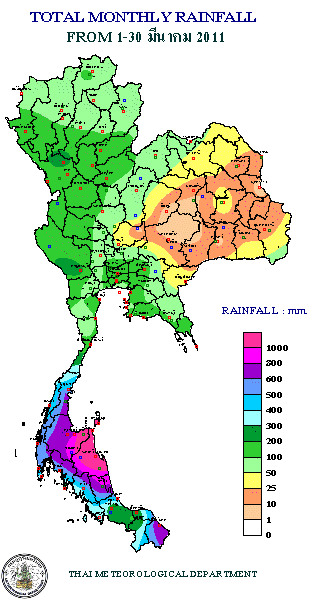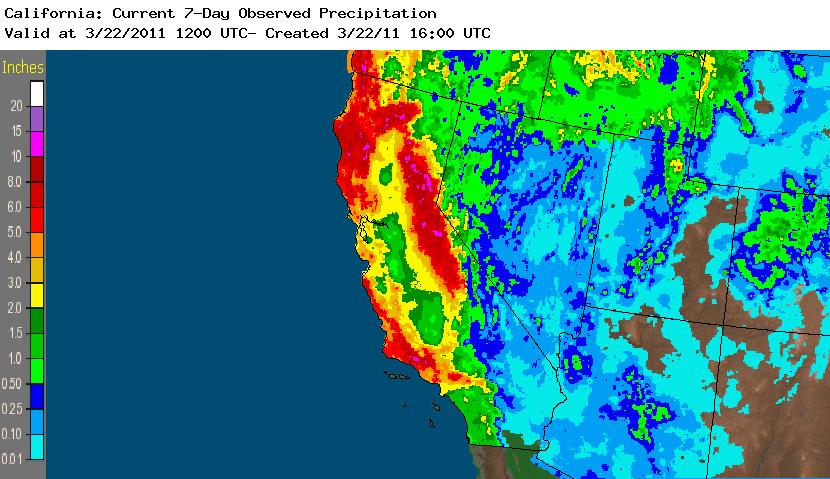Updated 7 April 2011

Extremely dry conditions over the past six months, intensified during the end of February and the first two days of March across much of the Florida Peninsula. Rainfall for the region was less than half of average for the six-month period (September-February) leading up to March. The dryness, combined with strong winds was associated with two large wildfires near Florida’s eastern coast, which burned more than 18,000 acres (7,284 hectares). The fires burned in Brevard and Volusia counties, where a mobile home, several outbuildings, and camp sites were destroyed. The Florida Division of Forestry deployed 37 plows, 20 fire engines, two helicopters, and two air tankers to battle the blazes. Nearly 290 people were mobilized to snuff the fires before they spread into more populated areas. One of the blazes crossed Interstate Highway 95, forcing officials to shut down a 21-mile (34-km) stretch of the busy road. Fortunately, the fires were fully contained before there was any loss of human life.

A low pressure system and associated cold front moved through the center of the U.S. on March 1st and interacted with an anomalously warm air mass causing heavy rains and storms in the midwestern United States. The warm temperatures and heavy rains, on top of above-normal snowfall during the winter, caused severe flooding to occur in the states of Illinois, Indiana, and Ohio. Rainfall up to 5 inches (127 mm) was reported across the region, adding to the runoff from melting snow. Numerous rivers breached their banks. Over two dozen people had to be rescued near Findlay, Ohio when waters from the Blanchard River inundated neighborhoods. A woman died when her vehicle was swept away by floodwaters. In northern Ohio, 700 people were evacuated due to fears of water overtaking neighborhoods.
Heavy rains and floods that began in late January in the southwestern African nations of Angola and Namibia left at least 25 people dead when rivers breached their banks the first week of March. The water level in the Okavanga River, which runs along the border of the two nations, was reported to be 26.2 ft (8 meters) above flood stage. In northern Namibia, 439 people were forced to evacuate to higher ground as flood waters approached their homes. No estimates of damages were released from either nation.
Monsoonal rains impacted the northeastern Australian state of Queensland the second week of March, causing flooding across a region that has been suffering from floods for the past several months. Many of the towns along coastal Queensland were still in the process of recovering from Cyclone Yasi. Reports of up to 10 inches (254 mm) of rain were reported in the town of Cardwell. Highways were inundated with water, cutting off the towns of Tully and Ingham from the outside world. Euroamo, near Tully, received 20 inches (500 mm) of rain in several days. One person was killed after her car was swept away by floodwaters north of Cairns. The rains disrupted the trip of Great Britain’s Prince William, who was planning to tour the areas impacted by Yasi the previous month.
Unusually heavy spring rainfall caused flooding and landslides across southern Thailand between March 26th and 31st. In the Surat Thani province, as much as 50 inches (1,270 mm) of rain fell in six days. The March average rainfall for the province is 2 inches (51 mm), with the weather typically being hot and dry during the month. According to the Thai Interior Ministry, at least 40 people died due to flood waters and mudslides in eight provinces. In total, over one million people were impacted. Over 60 roads and rail links to the southern region of the nation were choked off and nearly 15,000 tourists were trapped. Ferries to popular tourist destinations in the Gulf of Thailand and Andaman Sea were cancelled due to rough seas, also stranding tourists. Around 13,000 vacationers were isolated on Koh Samui, causing fears of food and fuel shortages on the island. The Thai military used their only air craft carrier to rescue a thousand people stuck on Koh Tao Island. Many of the tourists stranded were international and had come from the U.S., Australia, France, the United Kingdom, and Russia.

A storm moved across Greece, causing chaos around Athens on March 7th and 8th. Several inches of snow and winds gusting up to 80 mph (128 km/hr) were reported across the Mediterranean nation. A traffic jam due to the snow outside Athens stretched for 9 miles (15 km), and the electricity to many of the Greek Islands was cut. Several highways and ferry services were forced to close. The country deployed 50 snow plows with 50 tons of salt to fight the bad driving conditions. Coastal flooding was widespread, driven by the strong winds piling up water in harbors. Temperatures in Athens dropped to 0°C (32°F) on the 8th — the average daily minimum temperature this time of year is 7°C (45°F)
A series of strong storms slammed into the California coast between March 18th and 26th, bringing heavy rain and snow to most of the state. Rainfall amounts of up to 10 inches (254 mm) were reported in the San Fernando and San Joaquin Valleys. Burbank, California received 3.85 inches (97.8 mm) of rain, breaking a 38-year old daily rainfall record. Los Angeles also broke a daily rainfall record with 2.42 inches (6.1 cm) observed downtown on the 20th. Several feet of snow was reported across the mountainous regions of the state. Mammoth Mountain in the Sierra Nevada Mountain range received over five feet (152.4 cm) of snow from the storm. Other mountain locations received several feet of snow as well, trapping campers and hikers. In Yosemite National Park, 200 visitors were evacuated due to the deteriorating weather conditions. In Los Padres National Forest, 32 hikers had to be rescued, while a group of 100 teenagers was snowed in for over a day at a campground until the roads could be cleared by plows. Interstate Highway 5 was closed for more than 12 hours on the 20th due to the snow, forcing travelers to take refuge in nearby hotels. The storm brought an isolated and small tornado to the San Francisco Bay area, which caused no damage. The storm could potentially impact the upcoming growing season in the San Joaquin Valley, where flooded fields might promote the growth of fungus on fruit and nut trees.

A fierce late season snow storm hit the northeastern U.S. and southeastern Canada between March 5th and 7th. Locations in upstate New York and Vermont received up to 30 inches (76.2 cm) of snow from the storm, topping off a very snowy winter in the region. In Vermont, a portion of Interstate Highway 89 was closed due to zero visibility. More than 50,000 power outages were reported at the storm's peak across New York and Vermont. The airport in Burlington, Vermont received 25.8 inches (65 cm) of snow from the event, the largest March snow storm on record. Farther east, warm air caused the precipitation to fall as heavy rain, melting snow that was already on the ground, resulting in flooding. Major flooding and mudslides were reported in Connecticut, where two homes were swept into the Housatonic River. Ice jams in rivers across New England caused many rivers to breach their banks. Four deaths were reported across southern Quebec due to snow-related automobile accidents. Up to 20 inches (50.8 cm) of snow were reported in the Canadian province. According to Montreal city officials, 1,000 snow ploughs, trucks and other snow removal equipment were dispatched to clear the city.
 NOAA's National Centers for Environmental Information
NOAA's National Centers for Environmental Information



